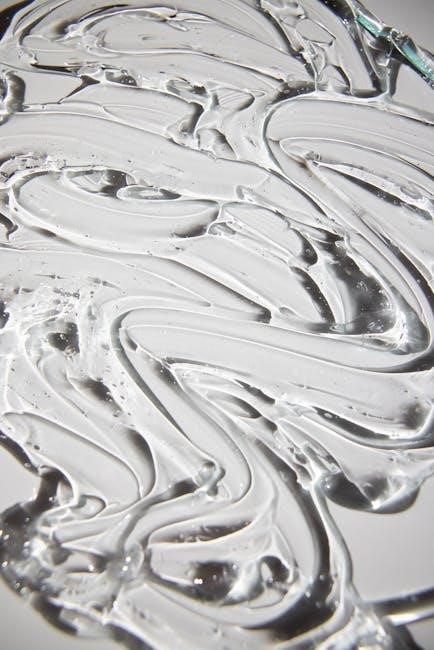General Finishes Gel Stain is a popular choice for furniture restoration, offering rich colors and easy application with proper instructions and techniques available online always.
Overview of the Application Process
The application process of General Finishes Gel Stain involves several key steps, including preparation, staining, and sealing.
The stain is typically applied in a thin, even layer, allowing it to dry completely before applying additional coats.
A high-quality brush or cloth is recommended for application, as it will help to ensure a smooth, even finish.
It is also important to work in a well-ventilated area, as the stain can emit strong fumes.
The entire process, from preparation to completion, can be completed in a relatively short period of time, making it a convenient option for those looking to restore or update their furniture.
By following the recommended application process, users can achieve professional-looking results with General Finishes Gel Stain.
The stain is versatile and can be used on a variety of surfaces, including wood and metal.
Overall, the application process is relatively straightforward, making it accessible to users of all skill levels.
Proper technique and patience are essential for achieving desired results.

Preparation for Applying General Finishes Gel Stain
Proper surface preparation is necessary for successful application always using clean rags.
Importance of Working in a Well-Ventilated Area
Working in a well-ventilated area is crucial when applying General Finishes Gel Stain, as it helps to prevent the inhalation of harmful fumes and ensures a safe working environment.
The use of open windows and doors or other means to maintain fresh air flow during application and drying is highly recommended.
This is especially important when working with oil-based products, as they can release strong fumes that can be hazardous to health.
By working in a well-ventilated area, individuals can minimize the risks associated with Gel Stain application and ensure a successful and safe project.
Proper ventilation also helps to prevent the buildup of fumes, which can be explosive in certain situations.
Overall, working in a well-ventilated area is essential for a safe and successful General Finishes Gel Stain application, and should always be prioritized.

Step-by-Step Instructions for Applying General Finishes Gel Stain
Follow specific steps and guidelines for successful application always using correct techniques.
Stirring the Stain and Maintaining Fresh Air Flow
Stirring the stain is a crucial step in the application process, as it ensures that the solids are fully reincorporated, providing a consistent color and finish.
To maintain fresh air flow, open windows and doors, or use other means to ensure good ventilation during application and drying.
This helps to prevent the buildup of fumes and ensures a safe working environment.
Proper stirring and ventilation are essential for achieving professional-looking results with General Finishes Gel Stain.
By following these simple steps, you can ensure a successful application and a beautiful finish.
The importance of stirring and ventilation cannot be overstated, as they play a critical role in the overall success of the project.
With proper techniques and precautions, you can achieve a stunning finish with General Finishes Gel Stain.
Following the manufacturer’s instructions and taking necessary precautions will help you to achieve the desired results.
Troubleshooting Common Issues with General Finishes Gel Stain
Common issues with General Finishes Gel Stain include adhesion problems and color inconsistencies always requiring patience and attention.
Addressing Adhesion Problems on Knotty Pine Surfaces
To address adhesion problems on knotty pine surfaces, it is essential to prepare the surface properly, as pine is full of pitch and stain alone will not adhere well.
The solution involves sanding the surface lightly with 120-grit sandpaper and restaining the table.
Additionally, mixing 2 parts Gel Stain with one part Gel Satin Topcoat can improve adherence, allowing for a stronger bond between the stain and the wood.
This technique is particularly useful when working with knotty pine, as it helps to create a uniform finish.
By following these steps, users can achieve a professional-looking finish on their knotty pine surfaces, even when using General Finishes Gel Stain.
The key is to be patient and take the time to properly prepare the surface, as this will ensure a strong and lasting bond.
With the right techniques and preparation, General Finishes Gel Stain can be used to create beautiful and durable finishes on a variety of surfaces, including knotty pine.

Features and Benefits of General Finishes Gel Stain
General Finishes Gel Stain offers rich colors and easy application always with proper techniques.
Characteristics of Gel Wood Stains and Their Advantages
Gel wood stains have unique characteristics that make them a popular choice for wood finishing projects. They are heavy-bodied and do not penetrate as deeply into the wood as liquid oil-based stains, providing the deepest, richest colors. This characteristic allows for a more even color distribution and a higher build-up of stain on the wood surface. The advantages of gel wood stains include their ease of use, versatility, and ability to produce a wide range of colors and effects. They can be used on a variety of wood surfaces, including furniture, cabinets, and flooring. Additionally, gel wood stains are often less messy and easier to clean up than traditional oil-based stains, making them a convenient option for many woodworkers and DIY enthusiasts. Overall, the characteristics and advantages of gel wood stains make them a great choice for many wood finishing projects.

Best Practices for Applying Gel Stain and Gel Topcoat
Proper application techniques ensure a smooth finish always using Gel Stain and Gel Topcoat products correctly.
Techniques for Preventing Lap Marks and Achieving Desired Colors
To prevent lap marks, apply Gel Stain liberally and maintain a wet edge, as demonstrated in the video at 00:40, ensuring a smooth and even finish.
Using a cotton terry towel to wipe away excess stain is also crucial in achieving the desired color and preventing lap marks.
When working on large surfaces, it is essential to use an absorbent cotton terry towel or rag to remove excess gel stain, allowing for a more even application.
By following these techniques and using the right materials, users can achieve professional-looking results with General Finishes Gel Stain and avoid common issues like lap marks.
The key to achieving desired colors is to apply the stain in thin, even coats, allowing each coat to dry before applying the next one.
This approach ensures a deep, rich color that enhances the beauty of the wood.
Proper technique and patience are essential for achieving the best results with General Finishes Gel Stain.
Sealing and Protecting the Gel Stain Finish
Seal Gel Stain with High Performance Topcoat for protection and durability always following instructions carefully.
Instructions for Applying High Performance Topcoat and Cleaning Foam Brushes
To apply High Performance Topcoat, wait at least 72-hours after using an oil-based gel product, then follow the manufacturer’s instructions for application and drying times.
Use a clean, lint-free cloth to apply the topcoat, working in a well-ventilated area to prevent fumes from building up.
For cleaning foam brushes, use mineral spirits to gently remove any remaining gel stain or topcoat, then wash the brush with soap and warm water to remove any residue.
Alternatively, use inexpensive foam brushes and dispose of them after use to avoid the hassle of cleaning.
By following these instructions, you can achieve a professional-looking finish with your General Finishes Gel Stain project, and keep your tools and workspace clean and organized.
Proper application and cleaning techniques are essential for a successful project, and can help you avoid common mistakes and problems.
Always read and follow the manufacturer’s instructions for the best results.